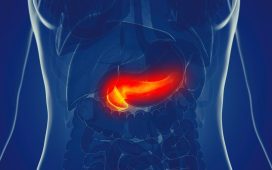74 percent of patients had the same changes from pretreatment to posttreatment with T1 + contrast and MRI-linac lesions
By Elana Gotkine HealthDay Reporter
FRIDAY, Oct. 11, 2024 (HealthDay News) — For patients with glioblastoma imaged daily with magnetic resonance imaging (MRI)-linear accelerator (linac) throughout the chemoradiation therapy course, anatomic changes can be detected, according to a study published online Sept. 30 in the International Journal of Radiology Oncology – Biology – Physics.
Kaylie Cullison, Ph.D., from the University of Miami Miller School of Medicine, and colleagues examined dynamics of daily glioblastoma evolution during chemoradiation therapy among 36 patients with glioblastoma. Tumor or edema (lesion) and resection cavity dynamics were analyzed throughout treatment on 0.35T MRI-linac and at three timepoints (T) with and without contrast (C) on standalone high-field MRI. Of the patients, eight, 12, and 16 had cavity only, lesions only, and cavity and lesions, respectively.
The researchers found that on MRI-linac scans, 64 and 46 percent of the patients had lesion growth and cavity shrinkage during treatment, respectively. The average MRI-linac migration distance was 1.3 and 0.6 cm for lesion and cavity, respectively. There was a strong correlation observed for standalone versus MRI-linac volumes (R2 values of 0.991, 0.972, and 0.973 for T2 versus MRI-linac cavity, T1 + C versus MRI-linac cavity, and T2 versus MRI-linac lesion), respectively. A moderate correlation was seen between T1 + C and MRI-linac lesions (R2, 0.609). In patients with all available scans, from pretreatment to posttreatment, T1 + C and MRI-linac lesions changed together in 74 percent of patients (shrank, grew, and did not change in six, 12, and eight, respectively). Nine patients (26 percent) had growth on MRI-linac and shrinkage on T1 + C.
“Our study shows that these daily scans can serve as an early warning sign for potential tumor growth,” Cullison said in a statement.
Several authors disclosed ties to ViewRay.
Copyright © 2024 HealthDay. All rights reserved.








